After spending two weeks in Santiago, the capital of Chile, Mark, Maya, and I headed towards Argentina again.
Since we wanted an early start for the border procedure, we slept our last night at an extremely loud and busy fuel station, still in Chile, forgetting that we could have returned to a better spot in Argentina, before crossing the actual border.
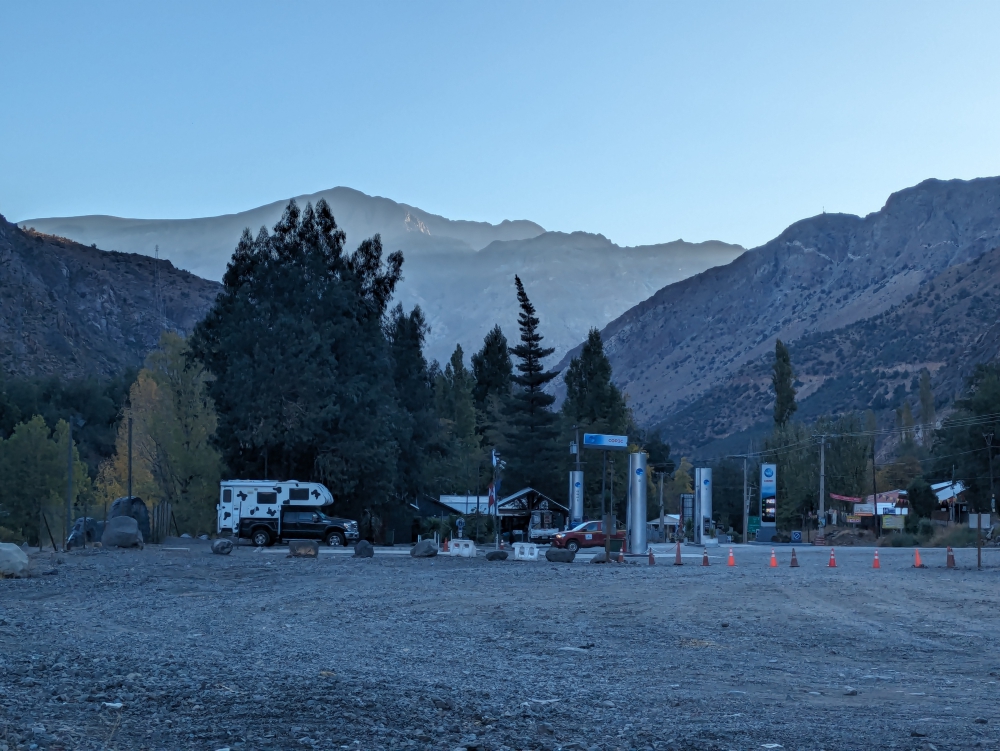
Parked by a loud fuel station
You see, official formalities take place in one building for each country and these buildings are 16 miles (25 km) apart! When you leave Chile, you don’t have to stop at the Chilean border facilities and vice versa. So, you can drive into Argentina and camp, before checking into the country. As a matter of fact, the actual border is located in the Christ The Redeemer Tunnel, which cuts through the Andes.
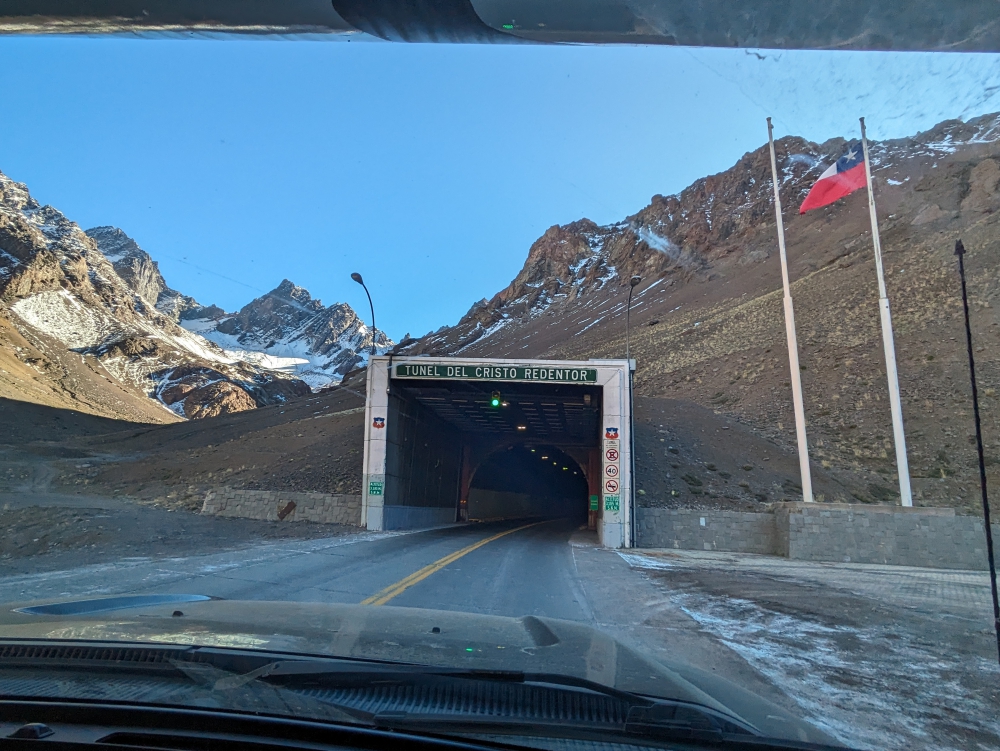
The actual border between Chile and Argentina is in this tunnel
And, a provincial park that contains the tallest mountain in the Western and Southern Hemisphere, Aconcagua, is also located in Argentina before crossing the border. Confusing?
Aconcagua Provincial Park
Our “early start” actually didn’t help, because we still needed to drive an hour to the border, navigating the tight and plentiful switchbacks called Los Caracoles to reach the Los Libertadores pass.
(As always, click on or hover over photos in galleries to read their captions.)
This area, including the border, frequently closes in the winter months due to heavy snowfall and rock slides. As the busiest and most popular commercial border crossing between Chile and Argentina, you can imagine the delays this might cause. Luckily, all was fine when we passed through in late April, but a week later, the pass closed for the first time this winter season.
On our drive, we also realized Aconcagua had to be seen and stopped at before the border formalities. I had hoped to do a hike here, but dogs weren’t allowed, you had to book ahead of time, it was freezing and super windy outside, and we had no idea how long the crossing would take. So, we briefly stopped for a free viewpoint and overlook of this majestic mountain.
Los Libertadores crossing into Argentina
We can honestly attest that this border crossing is one of the fastest and most efficient ones in South America so far. It’s a one-stop “shop,” where you park your vehicle in a huge hangar and stop by three different booths: Immigration to check out of one country and into the next with your passport, Chilean Customs to invalidate the car permit, and Argentinian Customs to request a new TIP (Temporary Import Permit) for the camper.
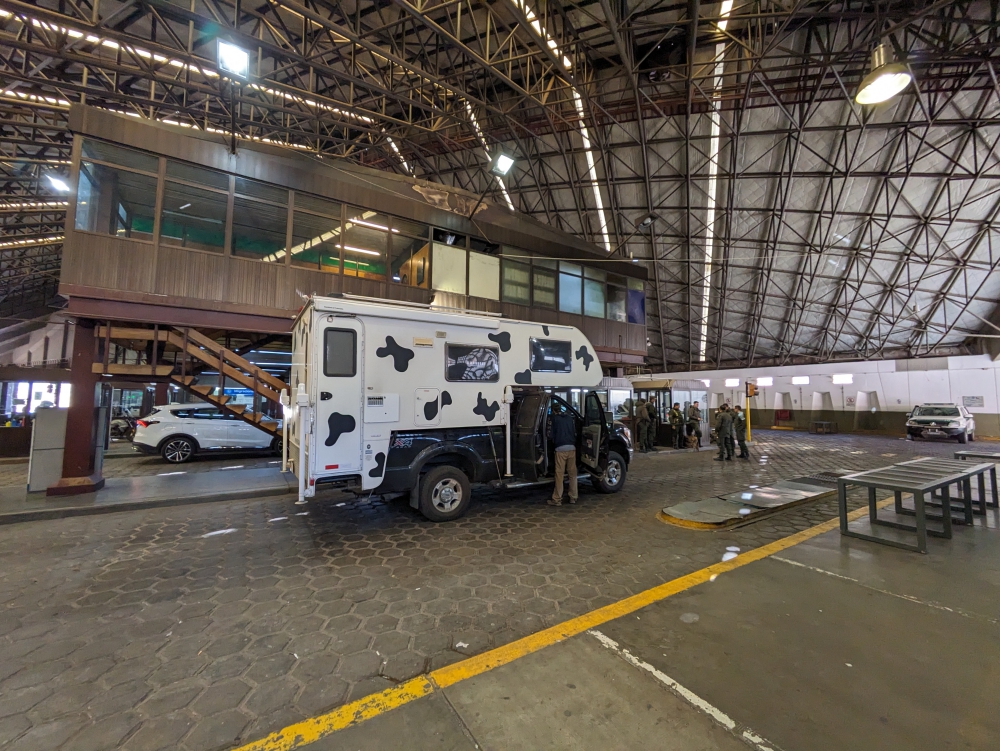
Border formalities to enter Argentina
This is where we needed to be super vigilant as we really needed this permit to be issued for eight months, since Mark and I plan to store Thirsty Bella in Buenos Aires during our upcoming summer trip in the Northern Hemisphere. I confirmed the duration with the official. It was a relief to hear him say “240 days.”
In the meantime, an Agriculture agent had shown up. He asked if we had a pet. After our affirmation, we handed him Maya’s paperwork and he waited until we received our Argentinian TIP, before approving of our documents and having a quick look at our dog. Done! In all of twenty minutes.
As always, we felt elated to be finished with those formalities and we were excited to give Argentina another chance.
Inca Bridge
This colorful, stone bridge is another spot along Ruta 7 between the border and the first substantial town in Argentina. It is named after the presumable use of this bridge by the Incas. The multiple layers and colors are completely natural and have been created by minerals of the hot springs in this area.
Uspallata
Our first camping spot was located in a canyon along a pretty stream. This is where we noticed how much colder it had become and how the sun sat shorter and lower in the sky, making us struggle with power, just like in Santiago, when the trees blocked our solar panels. Having canyon walls around us meant the sun didn’t reach the camper until 10am and disappeared again by 3pm. This is also where we had to sit a few days, because I was suffering from heavy coughing, congestion, and throat ache. We eventually left to the town, because I needed medicines.
The main free camping area in Uspallata was super attractive with its green grass and picturesque babbling brook. It was in walking distance of grocery stores, a laundromat, and pharmacies, so one could be happy here for quite some time. Apart from the freezing nights. The heater in our camper became an important part of daily life!
Our friends Abigail, Richie, and Zoe from Meat Around The World happened to still be here, so we hung out with them a bit, managed to get our laundry done, worked, and soaked up the sun whenever she was present and not interrupted by Arctic blasts of wind.
Portrerillos Reservoir
After leaving Uspallata, we looked forward to camping by the stunning, azure-blue reservoir we had passed on our drive to Chile. We checked out boondocking spots all morning, taking photos along the way.
Unfortunately, the wind was too strong and icy to be able to enjoy our time here, so we kept moving along and eventually settled at a popular picnic area. To our surprise, a familiar camper pulled in and we appreciated the company of our meat friends again.
Mendoza
We opted to skip the hot springs in this area, because the vibe and crowds weren’t our thing, and continued towards Mendoza, a city we had briefly stopped at before our Chilean detour. The green surroundings had turned yellow. Fall was in full swing!
Our first camping choice was a grungy parking lot next to the commuter train station, since the location was central and in walking distance of a good grocery store and many attractive parks. We could fill our water tank for free, but we didn’t know how to feel about the scene, which appeared to be a mix of overlanders and locals living in their vehicles.
We explored town on a multiple-hour walk with Maya, passing through more green spaces and the ruins of a church, which was the only demolished building left after the earthquake of 1861. There is not much to see in Mendoza, but the city parks are excellent.
Abigail, Richie, and Zoe joined us again and we all went out for yummy pizza in a relatively fancy restaurant. It was the first time we ate out in weeks. The five of us shared a few meals together.
When our sightseeing and shopping were done, we moved into San Martin Park, like on our first visit to the city. It appeared much louder than we remembered, but we enjoyed the walks and the nearby bakery with fabulous, affordable breads.
Mendoza wines
When we left the city, we planned a day of vineyard visits and wine tasting in the Maipu region. The information we found in iOverlander was mostly outdated, so we had to manage some disappointments. Our first stop, Bodega Lopez didn’t offer free tastings anymore and tours (with a tasting at the end) had to be booked ahead of time and were pricy. The only way for us to taste anything was to buy separate glasses or a bottle to share at the bar or in our camper. Since none of that sounded appealing, we moved on.
Bodega Tempus Alba (still) had a self-guided tour with information plaques, a food truck, and a fancy restaurant. We had hoped to have a snack (maybe even lunch) and do a tasting here, which had raised prices at $5.50 a person for three fair pours. The reserves were more expensive.
Mark and I split all six “normal” flavors to try everything. To our surprise most of them tasted bland and we only liked one out of the bunch. When I checked the prices for the bottles, they started at a shocking $17! We had been able to buy great bottles of wine for $3 a piece in the grocery stores – and vineyards further north. Having lunch was also out of the question, with sandwiches costing $10 a pop. We split an order of two empanadas for $5 and found this “splurge” underwhelming.
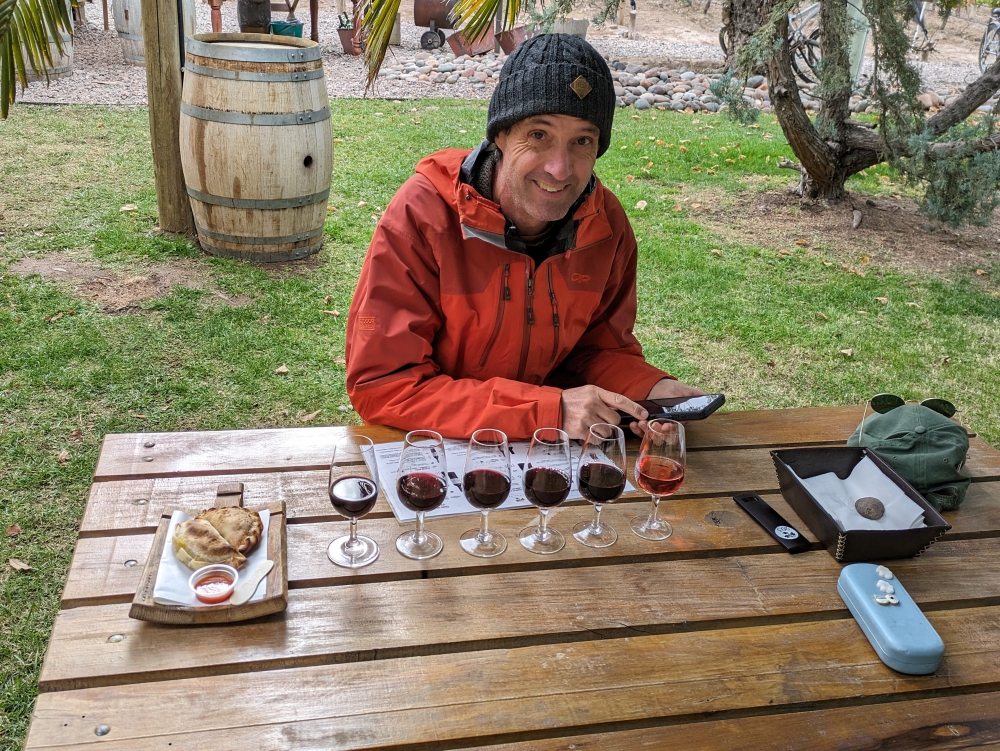
Trying out the different varieties of wine
Things were not quite going as planned. This area south of Mendoza was too touristy and expensive for us, with bike tours hitting up all the bodegas and olive producers. Speaking of which, we stopped at one of them, expecting to pay $3 per person for a wine, olive, and olive oil tasting. Upon our arrival, we learned the price had doubled (for non-Argentines) and the bottles of olive oil approached $15 for 500ml! We left.
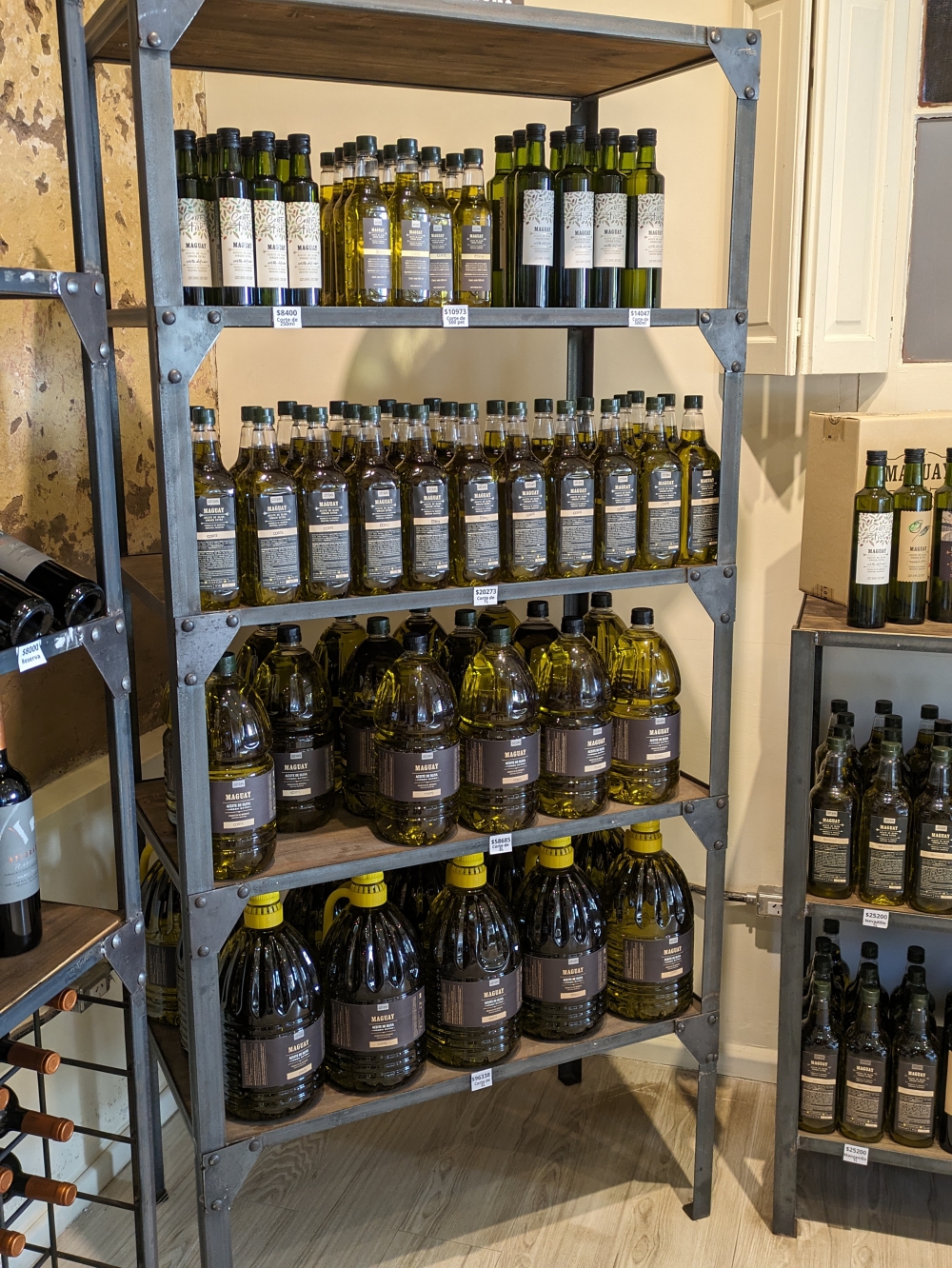
Quick stop at an olive oil shop
As we drove further along our route and bought produce at one of the stands, Mark and I had a chat and consequently cancelled our olive orchard tour and tasting for later that afternoon. Why would we spend money on things that don’t really interest us, are overpriced, and only seem to frustrate us? Done!
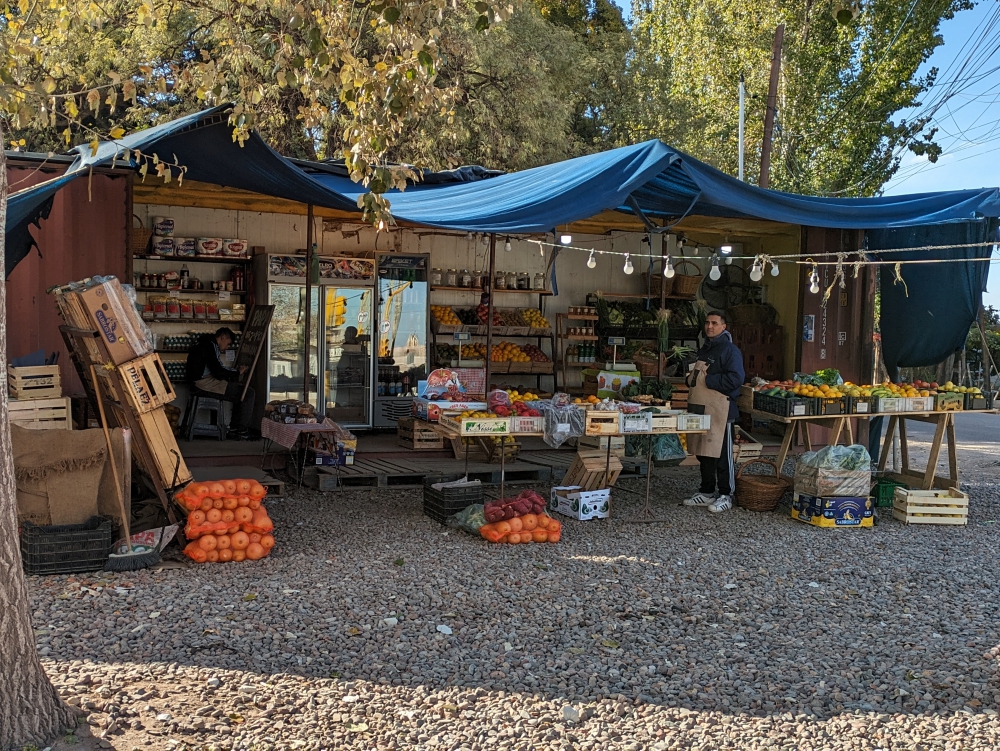
The produce stands in Maipu were good and affordable.
We would make one more stop before calling it a day: Bodega Giaquinta. Current prices seemed reasonable and we could potentially spend the night at the vineyard. And, just like that, our mediocre day turned wonderful!
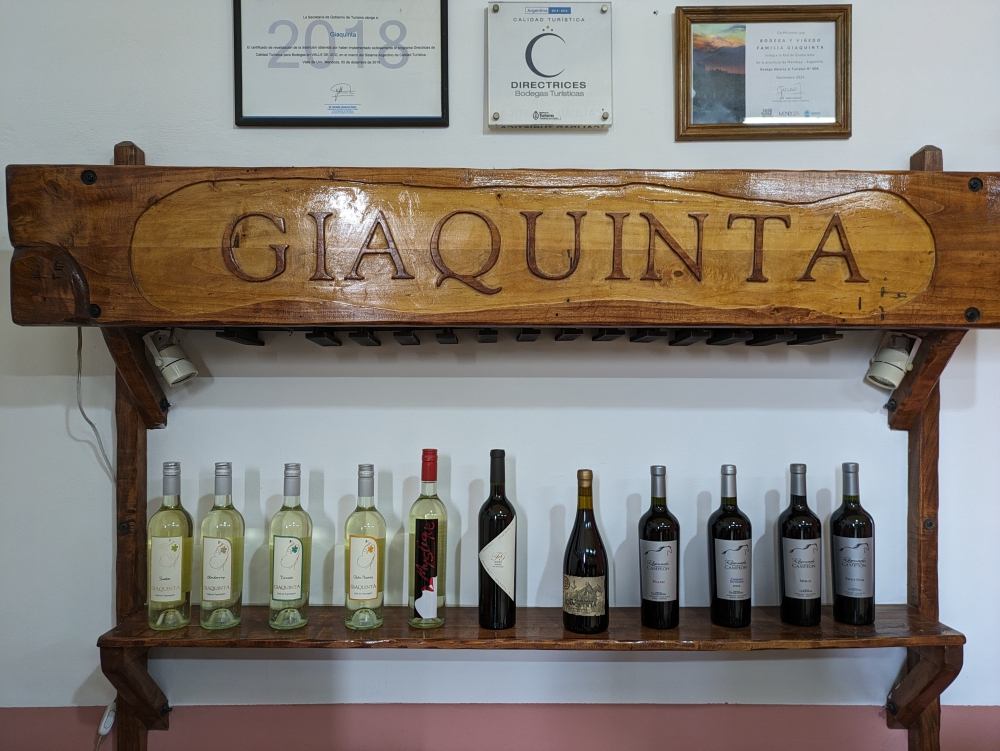
Moving on to Bodega Giaquinta in Tupungato
At this bodega, there were choices: only tour, tour and tasting, or just tasting. Yup. That’s what we wanted. The cheapest option was the best one! For $3.50 per person, we got to try six different wines, accompanied by crackers and cheese, and served by a friendly, patient, and knowledgeable hostess. We practiced our Spanish, answered questions about our lifestyle, and found a new favorite winemaker!
We thoroughly enjoyed each generous pour, tipped our guide, and bought a box of their Malbec and two bottles at good prices. Maya was welcome and rested by the table, as always.
The wonderful employee invited us to stay on the property, but we had learned that our Meat Around The World friends were camped close by and Mark craved an easy, hot shower, so we joined them.
Tupungato
The Municipal Campground of Tupungato was attractive. Cold, yes, even though we were only living at 4.600ft (1,400m), but so pretty in the fall. We managed with just long clothes and a raincoat, plus a wool hat, when outside. The heater was only on in the evenings and at night. We braved the cold walk and bathroom building for piping hot showers. And, we could top up our tank with fresh water. If we’d be equipped, we could even plug into electricity here, all for the price of $3 a night!
We enjoyed a wonderful dinner outside with our friends, before the sun disappeared and the outdoor AC turned on. Many dogs occupied this park and they all seemed well fed. The hungriest one appeared to be Maya, who, as always, eats whatever she finds. Although I have to admit that it was my fault that she devoured six raw eggs and the carton, when I postponed boiling them until later and left them on our table when we both ran to the shower block. No boiled eggs for us!
On the day we planned to head south, two things happened. Abigail, Richie, and Zoe departed and we learned that our friends Heather and Jon from Vermonster RV were headed towards Mendoza Province from Chile, to reset their visas. If we left this area, we wouldn’t be able to meet up. After quick deliberations, we decided to spend another day at the campground to make new plans and do chores, like bathing Maya and washing the sticky sleeping bag she used as a plate for her egg feast.
The cold temperatures were leaving their mark. The heater needed to be on a lot, we were chewing through propane, condensation formed every night, the collected water dripping on our bed and freaking Maya out. Between her being nervous and the sound of the heater, not much sleep was had, despite this being a super quiet location. We decided to move back to Mendoza while “waiting” for our friends, just to be at a 1,500ft (450m) lower elevation.
Back to Mendoza
So, yes, we drove 100 miles (return) and spent $40 in fuel to be slightly more comfortable and avoid the weekend at a municipal camping. We settled in the park again after a loud and sleepless night by the train station (including a move at 11pm, because of noisy neighbors) and stocking up our fridge and cabinets. The Meat Around The World crew joined us later for a nice evening in Bella.
Unfortunately, the sun had completely disappeared and it was cold, cloudy, and rainy in the city as well. The solar panels suffered, so we had to be careful with our Starlink internet and power use. Having friends around cheered us up and we spent our last evening together in their truck camper.
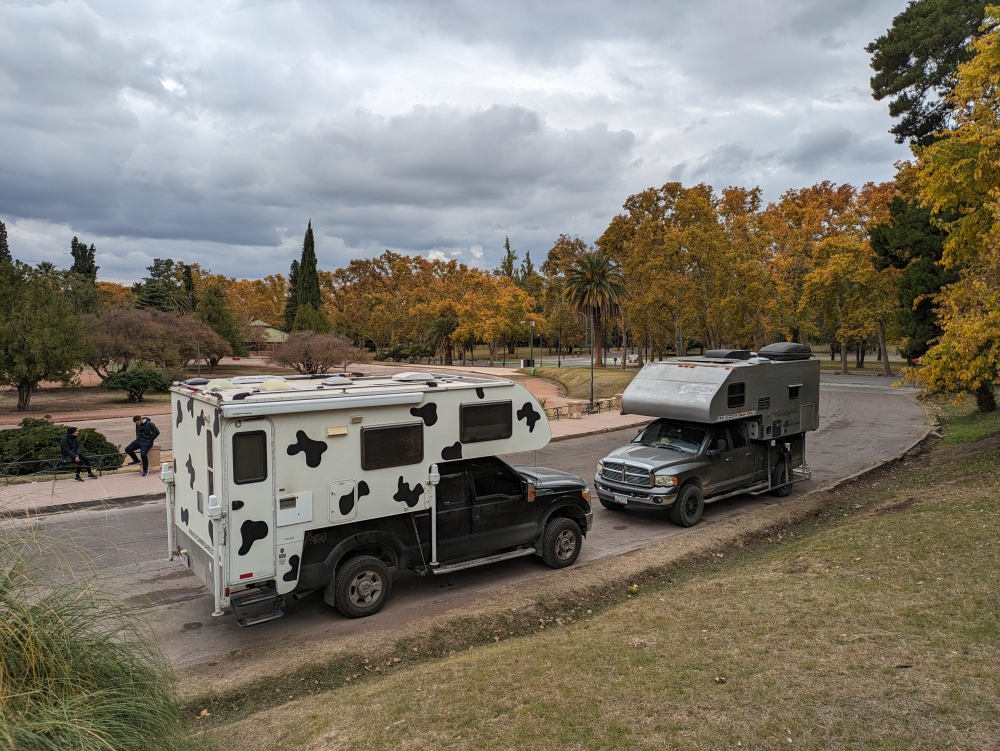
Camped in San Martin Park with Meat Around The World
In the morning, we hugged Abigail, Richie, and Zoe goodbye, knowing that, this time, we wouldn’t bump into each other again for a long time. Our crew headed south for one more excursion with Heather and Jon, before taking a turn east towards the capital.
Next up: Our expense report for May 2024
Curious about a previous ten-year chapter in our nomadic lives, which includes eight years aboard a 35-foot sailboat in the tropics with dogs, check out my compelling, inspiring, and refreshingly honest travel memoir:
Discover more from Roaming About
Subscribe to get the latest posts sent to your email.


































































































May 28, 2024 at 10:20
Fascinating that the border is setup in such a way that you can camp in a country before you cross their border check point. Great timing crossing Los Caracoles! Aconcagua is beautiful. Love the colors of the Inca Bridge. I feel your pain when you do lots of research and then come to find out reality doesn’t match. Thank goodness for Bodega Giaquinta. Love this phrase: “Outdoor AC.” ???? It must have been wonderful to be able to hang with friends for so long. Glad that worked out for you all. Thanks for sharing. Jim
May 28, 2024 at 19:14
Hi Jim,
Yeah, it’s like a nomad’s land between Chile and Argentina, but not really. Very different from other borders.
We usually don’t do a lot of research, because we know things might (will) be different whenever we arrive, but some planning is necessary, as you know. Flexibility is the name of the game!
It was wonderful to spend so much time with friends. And, more to come in a future blog post. It is quite unusual for us to be around people we know for this long, so we soaked it up. Back on our own again now! 🙂
May 28, 2024 at 10:55
Liesbet my name is flexible. I am always amazed how you roll with everything.
May 28, 2024 at 19:16
Hi Jacqui,
I certainly had to think about you when we encountered a new problem recently. One for which problem solving was very important! More about that later, but it involves butane not working in freezing temperatures! 🙂
May 28, 2024 at 12:29
You had some good experiences here – lots of time with friends, always important. I had to laugh at Maya eating all the eggs AND the carton!
May 28, 2024 at 19:19
Hi Anabel,
This time – and the week following – with friends was super precious. Socializing in a meaningful way doesn’t happen a lot when you live on the road, but is important nevertheless.
You know, Maya eats “everything” (literally; I can tell you many stories about that and you might even remember how she devoured two of my Plunge books a few years ago), but I have to think that cardboard is one of her all-time favorites. My guess is that she ate the eggs to get to the cardboard tray!
May 29, 2024 at 02:18
Too funny. You go to all that trouble to get her special food and she prefers cardboard!
June 3, 2024 at 19:47
Haha, Anabel. We do have a special, yet troublesome, girl. Last night, she kept us awake by trembling and anxiously moving around, because some pine needles fell on the roof in the wind. Yeah… it is always something that prevents us from sleeping!
May 28, 2024 at 13:28
The $3.50 wine tasting would be a highlight for me. I’m heading to Barcelona in the fall and hoping for some delicious Spanish wine tastes, however I doubt it will be at that price. Cheers and keep the posts coming!
May 28, 2024 at 19:21
Thanks, Heidi. I’m trying to slowly catch up with blog posts, but it can be a chore and so time consuming. I’ll get there soon, though. I have to, because I want to take a break (from the internet and life on the road) this summer!
We were excited and surprised about that wine at Bodega Giaquinta and hope to swing by again in the future. Enjoy your time in Spain!!
May 28, 2024 at 13:35
Those switchbacks are something else! Was it difficult to make the turns in the truck?
I guess you haven’t figured out why they leave full plastic water bottles at the shrines, yet?
Sometimes the least expensive experiences are the best. Glad you found a cheap winery with good wine. And all the cheese!
May 28, 2024 at 19:31
Hi Duwan,
The switchbacks were very doable – semi trucks constantly drive up and down them – but it was slow progress. We lucked out that the road construction and one-way traffic was in our favor and that the pass had been open before. The lines are horrendous after the border has been closed and with the road works.
Mark and I keep saying how the wine in Argentina has been the highlight of this country so far, and the only thing that is still affordable.
Yes, I figured out the reason behind the full water bottles, but I didn’t want to get into it in the blog, as it was long enough already. The bottles are for Difunta Correa or Deolinda Correa, the patron saint of travelers. Here’s some info about the story and practice: https://nelmitravel.com/shrines-in-argentina/ and this blog talks more about the Saint: https://www.timetravelturtle.com/argentina/difunta-correa/
May 28, 2024 at 13:46
The countries of South America have always seemed like a jumble to me. Thanks to you and Mark, I’m getting a better grip on the geography of SA.
Mark looks almost like a sommelier in one of the photos–ha!
Here’s to safe travels now and meeting up with more friends until your 240 days in the Northern Hemisphere.
May 28, 2024 at 19:52
Hi Marian,
There are actually not that many countries in South America. Asia and Africa have always been more difficult to memorize for me. And, in general, I don’t remember the geography well until I’ve actually visited the countries, so a lot of the world remains undiscovered and a mystery to me. 🙂
Neither of us are wine connoisseurs, but we have come to appreciate the smell and taste of different grapes and even learned a term or two along the way. Except, we’ve forgotten the Spanish versions.
Not sure if I could live for 240 days in the northern hemisphere without our camper. That amount of time is what our vehicle received in Argentina. It was either that or 90 days, which is what human visitors get and which wouldn’t have been enough to cover our summer trip up north. It’s all so complicated to explain! 🙁
May 28, 2024 at 15:10
You turned down a lot of overpriced items, but I was glad to see that some of your experiences were better later on.
You sure have a large contingent of fellow traveling friends. It’s nice to spend time to socialize or be alone as you choose.
May 28, 2024 at 19:59
Hi Pete,
It seems like the older Mark and I get, the more frugal we become. It’s weird, really. But, yes, we have come to terms with skipping sites and experiences when we think they are not worth their price. As we get older, we, of course, know more about what we want and what makes us happy. So, it actually happens often, for example, that we say “Let’s skip this restaurant meal and buy a few bottles of good wine with that money.” 🙂
There is one thing I don’t skimp on (when it’s within our budget): good bakeries. I’m a sucker for crunchy wholesome bread and quality pastries with yellow cream.
Unbeknownst to non-overlanders, there are quite a lot of us doing the same thing! Yet, finding travelers you connect with (that are not entitled, focused on social media, and ideally around our age) is not always easy.
The best friends are the ones you feel connected with, but who also allow enough space and time to do things separately. Like any good relationship, I guess. 🙂
May 28, 2024 at 16:17
I’m glad that you found a winery that fit both your budget and your taste. Of course, here in California, free or inexpensive wine tastings are a thing of the past unless you are a member. Oh well…
May 28, 2024 at 20:02
Hi Janis,
While we had good wine experiences (price/quality) in Northern Argentina, we feared that we wouldn’t find this in the (touristy) Mendoza area, until we stumbled upon Bodega Giaquinta. That made us happy to have “held out” and not give up. Tupungato is less touristy and visited than Mendoza, though. But more charming.
Luckily, you – and we – have been able to check out those Sonoma and Napa Valley wineries when they were still free or affordable. Good memories! And, once you have a few favorites, you can just buy them at the grocery stores in CA.
May 29, 2024 at 13:55
Didn’t think about the fact it’s almost winter there. When are you heading north?
Those wine and tasting prices sound worse than the vineyards near where I live.
June 3, 2024 at 19:50
Hi Alex!
The reason we haven’t driven north to escape the cold is because we are flying out from Buenos Aires soon, to spend summer in the northern hemisphere. We are very much looking forward to it!
May 29, 2024 at 15:52
It’s good to hear that you found some nice camping spots, and all in all it sounds as though the area you were in was a bit safer and “more civilized” than some of your previous experiences. I’m sure it was much easier for you to deal with the frustration of too-expensive tours than it was to deal with the fear and frustration of stabbed tires and almost-muggings!
June 3, 2024 at 19:53
Hello Diane!
Yes, Central Argentina has brought better sights and experiences than Northern Argentina, especially for Maya. The dogs seem friendlier here, haha.
All that being said, we feel like it’s been “always something” for weeks, recently, and the cold and weak sun (whenever even present) has caused us quite a bit of grief. At the moment, we are basically “waiting” for our flights back north and to prep and store the camper, enduring a lack of electricity and comfort and chilly weather.
May 30, 2024 at 08:59
I was caught by surprise that it is almost winter there. I suppose I thought you live in perpetual summer. 🙂 Anyway, so many beautiful photos in this post, visits with friends, and wine tastings. All good stuff. Passing on ‘overpriced’ experiences always leads to something better!
June 3, 2024 at 19:55
Haha, Suzanne. We wished we lived in perpetual summer and for a while it has felt that way. Until we crossed the invisible border into an area with seasons again. Thing is that we never seem to find the perfect weather and we often go from winter into summer, or vice versa, with fall or spring missing. Temperature wise anyway. We can’t wait to escape and experience a “real summer” again! 🙂
June 1, 2024 at 17:59
We will definitely hit that Bodega. We are planning a two week trip to the Mendoza area for the holidays in December. So, 240 days out of Argentina to points North. Where to?
June 3, 2024 at 19:59
Hi Susan,
How nice you plan a two-week vacation in the Mendoza area later this year. I would strongly recommend that Giaquinta Bodega (it’s not a pretty, vineyardy place, though, like you will find elsewhere) for the wines and the service and Atuel Canyon (a future blog post) for the drive and views.
I guess my mention of the 240 days was a bit confusing. That’s the amount of time our truck received in Argentina, which allows us (the people) to leave and store it here while we are gone to the US and Belgium for 3.5 months. If the vehicle wouldn’t have received that time but 90 days instead, we’d have a problem and needed to cross more borders in the hopes of receiving the 240 days elsewhere. I hope that makes sense?
June 2, 2024 at 09:37
The fall scenery is so pretty, and the cooler weather seems like it could make for cozy times in the camper!
June 3, 2024 at 20:01
Just what we need, Lexie, more time inside this tiny camper of ours. 🙂 But, you are right, the fall colors have been really beautiful. With fall, however, comes less sun and she sits lower in the sky, so we have been struggling with electricity and therefore comfort.
June 2, 2024 at 09:47
Six raw eggs and the carton? And then a sticky sleeping bag. I hope Maya was okay after eating all those raw eggs. Tell me, she didn’t eat the shells, did she?
It’s strange looking at photos of you folk in wooly hats and coats. Does the temperature go below freezing at night? Will you guys get to build a snowman before you come back North?
June 3, 2024 at 20:05
Oh Hugh, don’t you worry about Maya and her stomach! This animal eats everything. And, I mean, everything. Usually without ever getting sick, luckily.
So, yes, of course she ate the egg shells as well. Less harmful than books, tissues (including the cardboard box), paper towel (including the cardboard insert), toilet paper – soiled or not – and an array of discarded food and excrements she finds when out in nature… I’ll spare you the details. 🙂
I loved your questions at the end, as I’m sure I’ll show the answers in future posts and photos. Yes, it’s been freezing at night which has caused us heaps of issues (these campers are not built for extreme weather conditions) and, yes, I managed to make one small snowman.
June 2, 2024 at 19:20
Glad you had a number of positive experiences in this part of Argentina. Soon you’ll be heading to warmer weather in the USA and Europe. Safe travels!
June 3, 2024 at 20:08
Thanks, Natalie. We are slowly getting excited about our break from the road, especially since we haven’t been very comfortable lately, due to the weather and electricity problems. We can’t wait to prep the camper – and ourselves – for our summer up north. One more week! 🙂
June 6, 2024 at 16:10
Wow, what a magnificent journey in Argentina. What a treat to get through the border quick! And I was shocked to see olive oil in that supposedly cheaper neck of the world costing so much. It’s a fortune here too now, but that was a shocker. Enjoy! <3
June 7, 2024 at 11:53
Hi Debby,
We just have to remain vigilant and careful with what we spend our money on. Most travelers – and even locals – don’t seem to care and buy what they want, whether on credit or not. It’s engrained in us to weigh the options and the prices and shop accordingly.
When produce is out of season, we will skip it. For example, broccoli and cauliflower here in Buenos Aires cost $4 a pound now. That’s just too much. So, we eat squash, potatoes, and carrots, haha. Mark has created a wonderful recipe for squash soup. Perfect in this weather too! 🙂
I hope you are having a fabulous birthday today – and into the weekend! ❤️
June 7, 2024 at 15:21
That’s how we all have to do it Liesbet. I won’t buy veggies out of season either. They can rot! Lol. Thanks again for the lovely birthday wishes my friend. Enjoy! <3
June 9, 2024 at 15:18
Yeah. We have to shop wisely to save money. It’s just so wasteful to see those fancy vegetables and fruits rot. It happens here as well. Even with smaller vendors. I don’t understand why they don’t lower the prices when produce gets overripe! We’ve seen sooooo many avocados at stands rot, this last year and a half.
June 10, 2024 at 07:47
That is so sad waiting for veg to rot instead of putting on sale. But greed rules globally now. 🙁
June 14, 2024 at 16:46
🙁